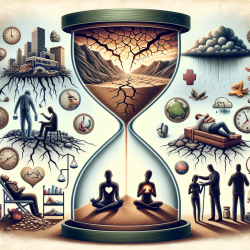Introduction
The Spitak earthquake of 1988 was a catastrophic event that left a lasting impact on the mental health of those who experienced it, particularly adolescents. A recent study titled "25-year follow-up of treated and not-treated adolescents after the Spitak earthquake: course and predictors of PTSD and depression" provides valuable insights into the long-term effects of this disaster on PTSD and depression. This blog explores the study's findings and offers practical applications for practitioners working with trauma survivors.
Key Findings
The study followed 142 early adolescents from two cities, Gumri and Spitak, over 25 years. Key findings include:
- Significant decrease in PTSD rates over 25 years, yet 9.1–22.4% still met DSM-5 PTSD criteria at follow-up.
- Adolescents from Spitak, who experienced fewer post-earthquake adversities, showed a greater decrease in PTSD symptoms.
- Treatment at 1½ years post-earthquake resulted in significantly lower PTSD and depression scores at 25 years.
- Risk factors for PTSD included home destruction, lack of social support, and chronic medical illnesses.
Practical Applications for Practitioners
Practitioners can enhance their skills by integrating the study's findings into their practice:
- Implement Trauma-focused Treatment: Early intervention with trauma-focused therapy can significantly reduce long-term PTSD and depression symptoms. Practitioners should prioritize such interventions, especially in school settings.
- Address Post-disaster Adversities: Alleviating adversities and improving the social environment post-disaster can enhance recovery. Collaboration with community and governmental organizations is crucial.
- Monitor Chronic Illnesses: Regular health check-ups for chronic illnesses should be part of the recovery plan, as they are linked to persistent PTSD and depression.
- Enhance Social Support: Building strong social networks and support systems is vital for long-term recovery. Practitioners should encourage community engagement and family support.
Encouragement for Further Research
The study highlights the need for further research into the differential impact of trauma on various age groups and the long-term benefits of early interventions. Practitioners are encouraged to contribute to this growing field by conducting longitudinal studies and sharing their findings.
To read the original research paper, please follow this link: 25-year follow-up of treated and not-treated adolescents after the Spitak earthquake: course and predictors of PTSD and depression.










